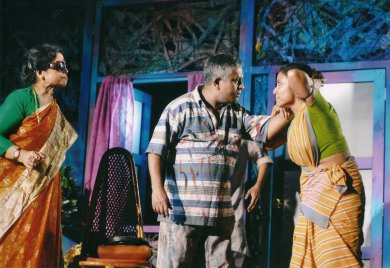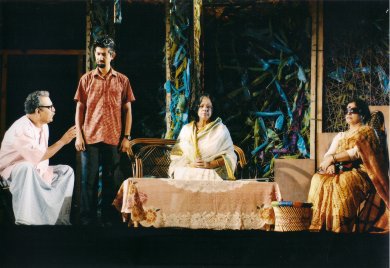
|   |

|   |
 e-mail: ukb7@rediffmail.com The good, the bad and the ugly August 27, 2018 In the variegated schema of life, there is seldom any certainty which qualities one is going to encounter over the entire range of urban society and its deep entrails. Can there be a wide enough canvas to draw one's urgent attention to the prevailing ills and can there be a flicker of light that may just per chance lurk at the end of the tunnel of darkness? The veteran playwright Manoj Mitra can wield an acerbic pen if he chooses and still retain his sympathy unerringly with the underdog. In his pen-portrait on the melting pot of the rampant ills in the emerging middle class of Bengal's metropolis, he uncannily lists them as the old parents' solitude with the generation next emigrating to greener pastures; the rape as an unmitigated evil and its devastating effect on the survivors; the menace of promoters out to grab the available urban property; the vicious nexus of the political and the business class; the oppression of women belonging to the marginalised community; and the one-way push nudging the hapless aged towards the lonely old-age homes. And, yet behold, the downtrodden can unite and rise, literally like a Phoenix, from the ashes! Chhoto Chhoto Bari (Home Little Home), presented on August 14 by Anya Theatre, was almost a textbook study of Kolkata's fractured society by Mitra that was dissected with a sure grasp on the theatrical landscape by the thespian Bibhash Chakrabarty. Shantivan (the Peace Abode) is a cluster of small houses located in a Kolkata suburb, built and nurtured by a handful of middleclass families, symbolising their desire, dream and hope to spend the rest of their life in peace. But then "sharks" literally invade the tranquillity of their lives, in the shape of a conglomerate of big-time promoters, small-time politicians, corrupt administrators and complicit policemen who are out to grab their small holdings - with the sole aim of building high-rises, shopping malls and multiplexes. In a series of scenes, it is seen how any resistance offered is crushed with mindless machinations and, if needed, with brutal violence. 

Typically, Kanakchampa (well enacted by Krishna Dutta), a middle-aged widow, who had fled her hometown Benares after her husband committed suicide - unable to survive the aftershock of his wife having been raped by some miscreants - is now a maker of one such little home in Shantivan. Once the news spreads that her young son Bubai (essayed well by Chiranjib Nath) would leave for the States on an assignment, she becomes the soft target of the same evil forces stalking the locality. No sooner her scion has left home than "the people" start descending on her with shady proposals and deals, with their ulterior motif being her eviction from home. She resists head-on and finally a young village belle Bindi - who is herself a victim of cruel male oppression, and now earns her two square meals by running a wayside eatery, or occasionally by pressing clothes -- stands courageously by her side. Meanwhile, the "vultures" that appear to keep swooping on and off comprise Pakhi Nandi, Harekrishna, Dhulubabu, Puramata, chairman, Rohan, Dulal and sundry others. In fact, there is almost a surfeit of characters in a straightforward play, but the focus is steadfastly on a gathering storm that wants to throw Kanakchampa out, once for all. In a realistic setting and through verbal fireworks that keep flying to and fro, the performance keeps the audience glued to their seat till the end. Extracts from a dialogue with the Director: How credible are the happenings depicted in the play? Very much. If one is living in any part of our country, especially in the state of West Bengal -- either in the cities or in the suburbs, or even in the villages - one gains the first-hand experience of such property or land grabbing by the promoters and land mafias, or one must have watched such things happening to others in one's neighbourhood. But does it generally tantamount to a bigger story? Yes, one could easily relate such small incidents to the bigger scenario: of big fishes swallowing the small ones, the big business stepping into the domain of the small retail business, thus marginalizing a section of our society who would otherwise like to eke out a living honestly and diligently. This has almost become the order of the day. What dramatic language did you devise to depict the action? In trying to treat the apparently naturalistic linear narrative of Shantivan and Kanakchampa, I wanted to relate the micro to the macro, the particular to the general. In trying to do so, I had to innovate a suitable theatre language through imaginative use of the stage design, lighting, puppetry and music. What has been your goal? I wanted to show the creatures of "the dark" trying to swallow the small little homes people had built with love, passion and hope to make their abodes of peace.  Dr. Utpal K Banerjee is a scholar-commentator on performing arts over last four decades. He has authored 23 books on Indian art and culture, and 10 on Tagore studies. He served IGNCA as National Project Director, was a Tagore Research Scholar and is recipient of Padma Shri. Post your comments Please provide your name and email id when you use the Anonymous profile in the blog to post a comment. All appropriate comments posted with name & email id in the blog will also be featured in the site. |